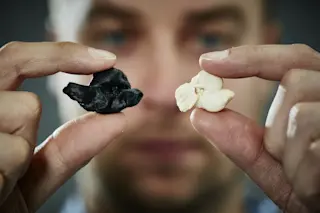Comparison of inner the inner ear bone (cochlea) of a xenorophid, left, and a modern-day dolphin, right. (Credit: Museum Victoria/Ben Healley) Modern whales and dolphins navigate in the oceans using echolocation, a system that bounces sounds off objects to reveal their details and distance. These magnificent marine mammals use their distinctive, high-frequency sounds for communicating with each other and hunting prey. The development of this important sensory system was a crucial factor in the evolution of odontocetes, the group that includes toothed whales and dolphins. Now, an international team of researchers has discovered when this key adaptation evolved in their now extinct ancestors.
Using CT scanning, a method originally designed for medical applications, researchers peered inside the fossilized ear bone of an ancient, 26-million-year-old relative of modern odontocetes known as a xenorophid. This method is really taking off in paleontology, says Travis Park, a PhD student at Museum Victoria and ...














